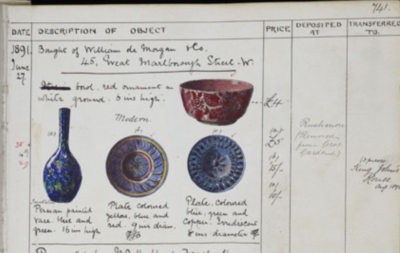Scholar and researcher, Rosemary Pemberton, reveals the De Morgan ceramics in the Pitt Rivers collection.

Augustus Pitt Rivers (1827-1900) was one of the richest men in Victorian England, a noted collector of ethnography and an eminent archaeologist. Therefore, it might come as a surprise to discover that he patronised the Art Potters of his age. He acquired items from Aller Vale, Doulton, Poole and the Martin brothers. However, his most significant contemporary purchases were from De Morgan’s workshop in Cheyne Row and later from the store in Great Marlborough Street, buying between 1884 and 1895. We know about the 25 pieces he purchased because he had all his collection illustrated in catalogues, now owned by Cambridge University Library.

The pieces he bought included a Della Robbia figured panel, bowls, plates, bottles, vases and a jug. Pitt Rivers can therefore be considered one of the earliest significant collectors of De Morgan. He displayed these pieces in his London home as well as his country mansion, Rushmore House, on the Wiltshire/Dorset border.
Pitt Rivers was a fervent believer in educating the public through displays of material culture. His ethnographic collection had already been donated to Oxford University and displayed there in the museum that bears his name. In the early 1880’s he developed a museum and gallery on his estate. Farnham Museum was set up to educate the local agricultural population and King John’s House, a medieval building, became an Art Gallery. Though one piece of De Morgan ware was displayed in the museum, more were shown in his Art Gallery, By the time of his death around 20,000 members of the public visited these two institutions per annum.
Three rare pieces stand out in his catalogues. There are two plain silver lustre pieces illustrated in his catalogue, a vase and a jug. Pitt Rivers obviously considered them special as in his exhibition of ‘Pictures and Objects of Art’ of 1895 held at his pleasure gardens, the Larmer Grounds, he described them as ‘Two remarkable specimens of silver lustre’.The closest known existing match to these is a vase held at the New Walk Gallery, Leicester. The third piece is pitcher shape in form and described in the catalogue as bought in August 1892 and that ‘This piece has lustre on one side only. It is quite by accident that lustre occurs on De Morgan’s red vases.’
Images reproduced with the kind permission of Cambridge University Library
You can search for all these pieces on the Rethinking Pitt Rivers website. http://web.prm.ox.ac.uk/rpr/ databases





